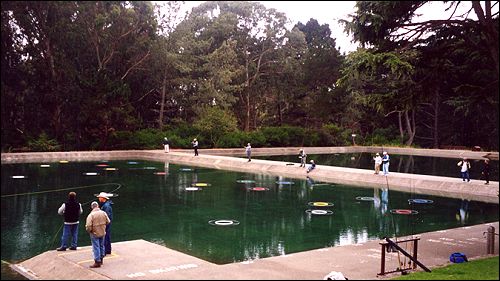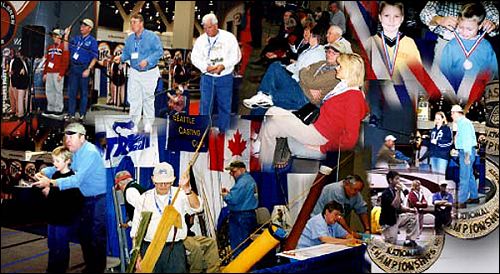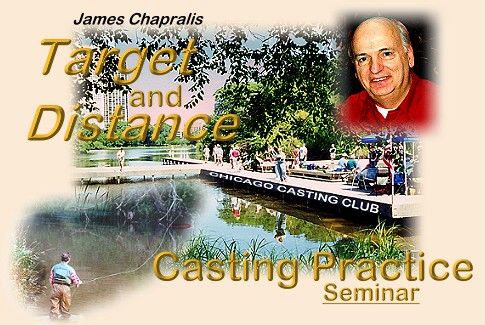|
You probably became interested in casting
practice because you realized that better
fly-casting skills generally result in
improved catches. To be able to place a
fly a few feet in front of a slurping fish;
to be able to cast a longer line than you
ever thought possible to reach that wary
bonefish; to be able to deliver an air-resistant
bass bug or permit fly exactly where you want
to place it - well, that's a wonderful payoff
and well worth all the practice hours and effort
you've invested.
Perhaps one day you conclude that casting
itself is fun. "Yeah, I'd rather be fishing,
but I can't go all the time. I wish there
were a casting club near me..." (assuming
you don't live near a casting club).
Well, start one.

It doesn't have to be a magnificent shrine
like San Francisco's Golden Gate Angling and
Casting Club, (shown above). It can be a casual casting club
that is conceived by you and a couple of
fishing friends or family members. Here is
a checklist to help you:
THE CASTING FIELD: First you need to
find a convenient casting place, which can
be at a park, a swimming pool, an athletic
field, a pond or a lake. Water or land. You'll
need about 120 feet for accuracy events (remember,
you have to allow for a back cast) and maybe
200 feet for distance casting (again, you need
room for a back cast), and about 40 feet in
width. This should be relatively easy to find.
Give some consideration to wind conditions:
You want a place that's relatively calm,
especially for the accuracy games, and if
possible, an area where you can place your
targets in different directions to compensate
for any winds.
TARGETS: You don't need anything
expensive or complicated, and six Hula
Hoops will do for a start; or, you can
make your own from an old garden hose.
You'll need about 95 inches of hose for
each 30-inch target (30 in. X 3.1416 [Pi]).
Use duct tape to secure the ends together.
Targets should be no problem.
MEMBERSHIP: Recruiting other members
is usually just a matter of simple "marketing"
procedures, and there is no single formula
that is applicable to all communities. Here
are some avenues for finding other members:
Start with your fishing friends or family.
Contact your local fly shop or tackle
store. This can be mutually rewarding. Explain
to the owner or manager what you have in mind.
List all the advantages to his store. Emphasize
that casting will help his tackle sales because
better casters catch more fish and logically buy
more tackle. Ask him if you can provide an
attractive poster and a flyer for his store.
Be aware that many fly shops offer fly-casting
lessons (for a fee) and this could make an owner
hesitant. Explain to him that his new students
would benefit from a club where they can increase
their casting skills. You might even consider
partnering a casting club with a fly shop.
Contact your local newspaper's outdoor
writer and tell him about your plans for a
casting club and ask for his help. Pick a date
(weekend or evening) when you and others will
demonstrate one or two events to his interested
readers, and, of course, invite the outdoor
writer as an honored guest. If your newspaper
doesn't have an outdoor column, send the paper
a one-page news release, which should include
the five Ws (who, what, where, why, and when)
plus your contact phone number and e-mail
address. Newspapers are always looking for
community projects to write about.
Sportsman's or Outdoors Shows: Just
about every mid-sized city has an outdoor
sport show that generally takes place during
the winter months. Some of the shows offer
fly-casting exhibitions and instructions by
skilled casters. What a great place to get
members! Talk to the sport show people. Tell
them that you are starting a casting club and
ask them if they would place your club's
literature or posters at convenient places
near the casting demonstrations. Once you
have launched a successful casting club,
sport shows may even provide a free booth.
Obviously you will need appropriate literature
and be willing to give casting demonstrations
and instructions if requested.
Contact other sporting organizations.
Is there a fly-fishing club or TU or FFF
chapter near you? Or a hunting and fishing
club? These are excellent places for obtaining
some members, but work in conjunction with these
clubs rather than competing with them. Tip:
Clubs whose memberships are primarily composed
of plug casters and spinning enthusiasts may be
excellent places for prospecting. Many want to
learn to fly cast but may think it's too difficult.
Offer to help run a tournament for club members.
Other venues for recruiting members
will surely suggest themselves depending
on your community.
THE CASTING PROGRAM: Obviously there
is much flexibility to the casting program
and much will depend on the membership. You
might consider having informal tournaments
on some sort of set schedule (e.g., once a
week, once a month, whenever). Periodically,
you might have a more official fly-casting
tournament, with some name like Season-Opener,
Windy-City Fly Casting Championship or Waushara
County Tournament.
Keep it simple to start. The goal is to present
events that challenge the members' skill and
ability, but are not so difficult that they
become frustrated and look for another activity.
THE OTHER SEASON: In the northern
climes we associate fly fishing and fly
casting as a spring-to-fall happening. The
winter? Well, many anglers tie flies or become
involved in other activities. But why not
offer fly casting?
There may be a high school gymnasium, a health
club, an athletic club or some large hall that
might be suitable for fly casting during the
winter months. You may be able to make an
arrangement to use the facilities for a very
nominal fee or other value exchange. For
fly-casting accuracy events you don't need
much room (an indoor basketball court will
do nicely), and the fact that dry flies are
feathery light means that there would be no
damage to the floors (as opposed to plug-casting
weights). You will need a few Hula Hoops and
make sure that all participants wear the right
type of athletic shoes (so as not to damage
the floors). You might find that the winter
fly-casting sessions and even tournaments
become more popular than during the spring
and summer seasons because of the plethora
of outdoor activities, including fishing.
ORGANIZING THE CLUB: After a few
sessions and informal get-togethers, you should
plan a club organizational meeting, inviting all
members and prospects to participate. Decide on
the appropriate time to have such a meeting
(make sure that it doesn't conflict with the
World Series, Super Bowl, Air Shows, etc.).
Prepare a meeting agenda well in advance;
don't play it by ear. Here are some salient
points to be included in your agenda and some
general statements:
Mission of the club: Agree on the
club's mission or vision. For example: to promote
fly casting, increase one's skill, develop
comradeship, provide friendly competition for
those who want it, and, later, perhaps even
offer club fishing trips.
Casting club name: Select a
temporary name for your club. It can be named
after your town, e.g., Peoria Fly Casters, or
an individual, e.g., Jimmy Green Fly Casters
(Jimmy passed away recently and was one of
the great innovative forces in casting and
fishing). Explain that this is a temporary
club name and ask for other suggestions.
Budget and membership dues: Develop
a budget based on expected costs associated with
a modest new venture. How about $20 a year for
individual membership or $30 for families?
Explain that the money would be used for
printing brochures, buying more targets, etc.
Election of officers: Since you
and some of your friends initiated the club,
volunteer to serve as officers for the first
year; thereafter, officers would be elected
by the membership.
Committees: If you develop a
sufficient membership, you should ask for
volunteers for various committees. Examples:
Public Relations (someone who would
contact the media for future publicity of
tournaments or practices); Membership
(someone who would lead membership drives
and explore new ways to get members); Prizes
and Awards (to work with local business
for various prizes and donations. Incidentally,
prizes don't have to be fishing related, e.g.,
a gift certificate from a book store or a
clothing store, free car washes, dinner for
two at a restaurant, etc.). Club Identification:
Besides a club name, eventually you may want
to have a club logo, stationery (to write to
tackle companies, park districts, etc.), club
T-shirts, caps, etc.
ACA affiliation: You may also
want to become an affiliated American Casting
Association member club (ACA annual club
membership is only $50 per year).

Okay, you and your club are growing and growing.
You can offer club fishing trips (local or distant),
a picnic/tournament with family members participating,
perhaps chevrons for casting accomplishments. Many
things.
On the other hand, maybe your club has
only a half-dozen members and you want
to keep it simple and casual. No problem.
I believe the Seattle Casting Club has
only three members: Bill Van Natter, his
wife Peg and Charles Judy. They've won many
medals at National tournaments.
At the minimum, members enjoy a wholesome
activity and become better casters because
of competition and because they learn from
each other.
Casting clubs can be small or large, casual
or formal, but they should all possess the
main ingredient-FUN. ~ Jim C. Chapralis
About Jim:
Jim Chapralis is a world traveler, a pioneer in the international fishing
travel business, and author, most recently of Fishing Passion,
reviewed in our Book Review section. Watch for a new book from
Jim soon. He is an avid angler - and caster.
You can reach Jim via his website
www.AnglingMatters.com
|



